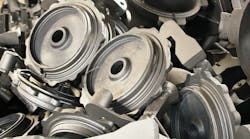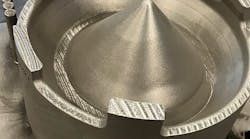Typical Flow schematic for dry sand fluidized MD Cooler Classifier
Lost foam dry-sand fluidized cooler for 50 tph.
Custom designed flask handler for Wind Energy Components >80 tons
While the economy is bouncing all over the map, and major capital investment plans are scrutinized more closely, delayed, or even cancelled, now is a great time to take stock of existing foundry operations. All foundry suppliers design and build great pieces of equipment to modernize operations; automation, additions, and expansions are commonplace, and the core of our long-term business models.
Even when they have little or no capital to invest, foundry operators will note that hard work and careful review of processes are always in order — and prudent. Despite the challenges to long-term planning (aggressive cost cutting, non-stop production demands, dwindling skilled workforces, the loss of experienced foundry technicians) there are steps that can be taken that have potential for a strong return on investment. Here are a few:
Process control — In order to remain competitive, all major foundry processes will be forced to adopt some method of process control; otherwise the operators’ competitive abilities will be compromised. Equipment upgrades and additional monitoring may help. If you are not already monitoring your key processes on a regular basis, with action plans to improve their capabilities, you may fall behind those competitors that do.
Equipment uptime optimization — Man-machine interface systems (aka HMIs) are a great tool to provide facts for all critical equipment and processes within the foundry. RS View, Intellution, Wonderware, are a few packages that can be integrated with existing equipment as significant steps toward optimizing the plant. Chronic downtime components can be evaluated and redesigned as needed to improve their performance. Few facilities have a surplus of maintenance technicians to evaluate key characteristics in the facility. Put some more tools in their toolbox; you’ll be pleasantly surprised to see the gains that can be achieved.
Additional sand screening — This will remove unwanted debris from the critical sand system processes, both no-bake and green sand. Unless your foundry is different than most, the greatest scrap percentage is from sand-related defects. Why not help every single part number in your mix with significant improvements to the sand itself through improved screening and cleaning? There are many ways to improve the system with either full time screening or off line laundering.
Sand temperature control — Whether no-bake or green sand, sand temperature control is paramount to optimizing system performance. Anyone with chemically bonded sand knows well what happens to strip time with only a slight unexpected increase in system sand temperature. There are many ways to address these issues through new equipment depending on the sand rate and the investment limits.
Electrical Demand Control and Energy Conservation — Do you manage and monitor your system demand? Do you understand (fully) how your bill is calculated? What about Power factor? Are you penalized for a poor power factor? When do you set your peak for the billing period? Do you have adequate data in-house to really understand what could very well be one of your largest expenses?
Sand Reclamation — Although sand disposal costs for the most part have remained surprisingly manageable, reviewing the foundry process, blending ratios, LOI control and levels of mechanical reclamation are all primary drivers of your overall system sand cost. Mass-flow balances of the foundry can uncover startling opportunities for review. Beneficial reuse abounds and also may offer great ways to minimize your foundry waste.
Also, consider the cost of labor, including safety considerations. Robotic systems, mechanized grinding and metal processing, and automated mold handling can make significant contributions to productivity costs.
Almost all major foundry suppliers have strategic experts in all of these areas. If you are not reviewing your operation and at least planning for improvements in these areas, you are probably getting left behind.
Andy Long manages Foundry Systems Design and Development for Vulcan Engineering. Visit www.vulcangroup.com











